Articulate, Present and Debate Ideas: Assessment Task 1 BSBCRT401
VerifiedAdded on 2023/06/04
|20
|4354
|155
Homework Assignment
AI Summary
This assignment solution addresses the core concepts of articulating, presenting, and debating ideas, covering essential aspects of effective communication in a business context. The document begins with a detailed exploration of how to present information to an unfamiliar audience, emphasizing preparation, audience engagement, and clear objectives. It then delves into various communication techniques, including tailoring presentations, responding to questions, and leveraging storytelling. The assignment also examines the role of risk-taking in idea presentation and debate, highlighting the importance of strategic and calculated risks. Furthermore, it analyzes key themes and messages within a growth business plan for a restaurant, illustrating practical application of the learned concepts. The document concludes by reflecting on techniques to engage the audience and ways to provoke responses.
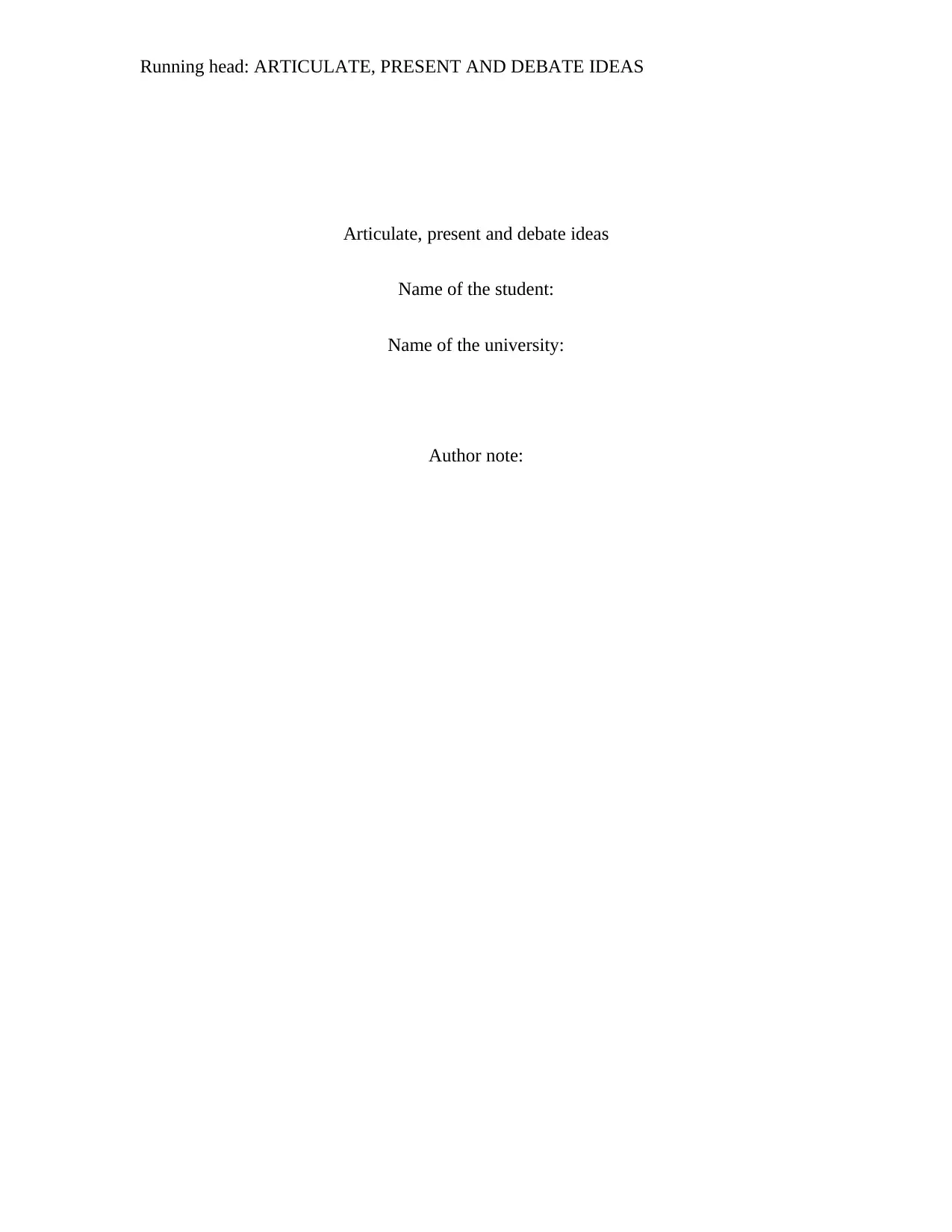
Running head: ARTICULATE, PRESENT AND DEBATE IDEAS
Articulate, present and debate ideas
Name of the student:
Name of the university:
Author note:
Articulate, present and debate ideas
Name of the student:
Name of the university:
Author note:
Paraphrase This Document
Need a fresh take? Get an instant paraphrase of this document with our AI Paraphraser
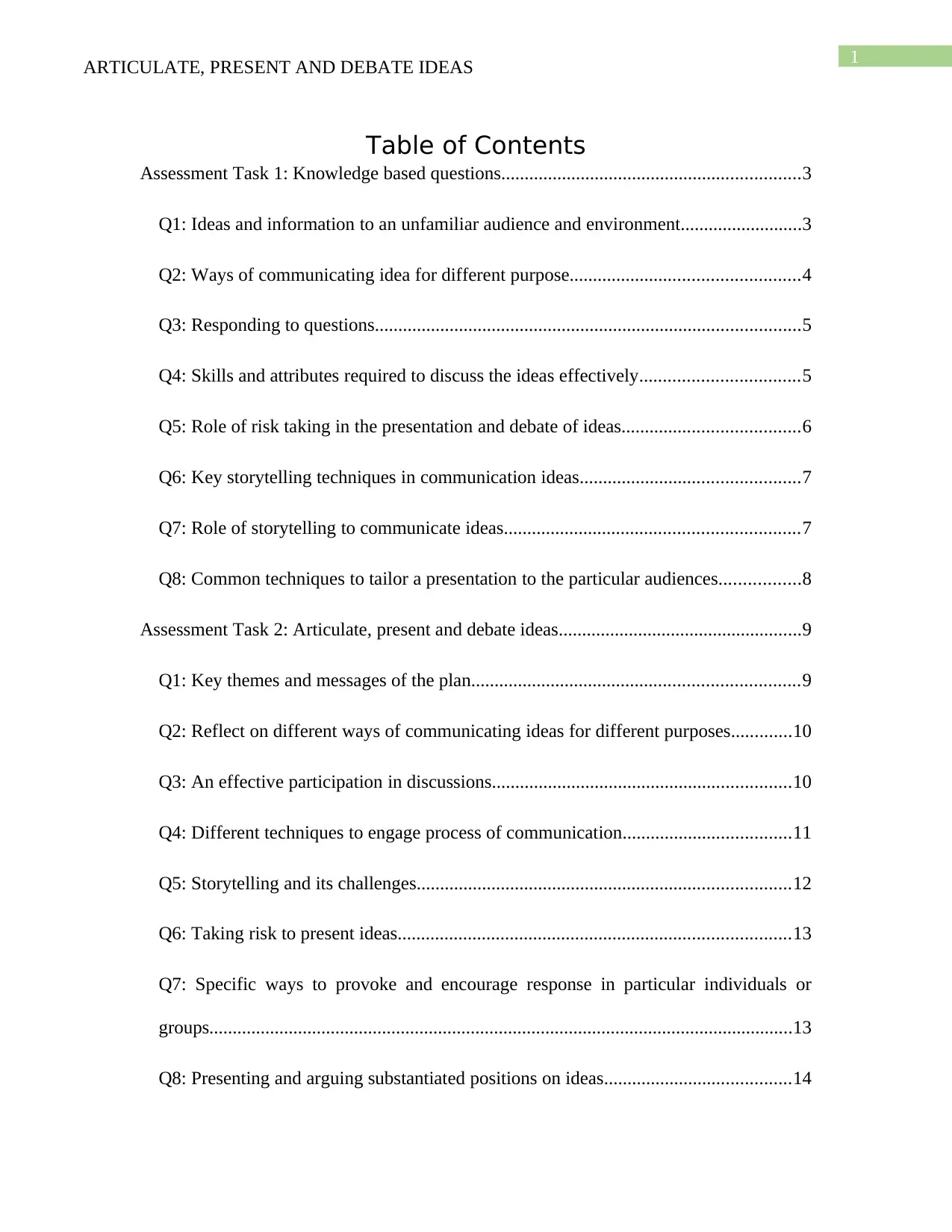
1
ARTICULATE, PRESENT AND DEBATE IDEAS
Table of Contents
Assessment Task 1: Knowledge based questions................................................................3
Q1: Ideas and information to an unfamiliar audience and environment..........................3
Q2: Ways of communicating idea for different purpose.................................................4
Q3: Responding to questions...........................................................................................5
Q4: Skills and attributes required to discuss the ideas effectively..................................5
Q5: Role of risk taking in the presentation and debate of ideas......................................6
Q6: Key storytelling techniques in communication ideas...............................................7
Q7: Role of storytelling to communicate ideas...............................................................7
Q8: Common techniques to tailor a presentation to the particular audiences.................8
Assessment Task 2: Articulate, present and debate ideas....................................................9
Q1: Key themes and messages of the plan......................................................................9
Q2: Reflect on different ways of communicating ideas for different purposes.............10
Q3: An effective participation in discussions................................................................10
Q4: Different techniques to engage process of communication....................................11
Q5: Storytelling and its challenges................................................................................12
Q6: Taking risk to present ideas....................................................................................13
Q7: Specific ways to provoke and encourage response in particular individuals or
groups.............................................................................................................................13
Q8: Presenting and arguing substantiated positions on ideas........................................14
ARTICULATE, PRESENT AND DEBATE IDEAS
Table of Contents
Assessment Task 1: Knowledge based questions................................................................3
Q1: Ideas and information to an unfamiliar audience and environment..........................3
Q2: Ways of communicating idea for different purpose.................................................4
Q3: Responding to questions...........................................................................................5
Q4: Skills and attributes required to discuss the ideas effectively..................................5
Q5: Role of risk taking in the presentation and debate of ideas......................................6
Q6: Key storytelling techniques in communication ideas...............................................7
Q7: Role of storytelling to communicate ideas...............................................................7
Q8: Common techniques to tailor a presentation to the particular audiences.................8
Assessment Task 2: Articulate, present and debate ideas....................................................9
Q1: Key themes and messages of the plan......................................................................9
Q2: Reflect on different ways of communicating ideas for different purposes.............10
Q3: An effective participation in discussions................................................................10
Q4: Different techniques to engage process of communication....................................11
Q5: Storytelling and its challenges................................................................................12
Q6: Taking risk to present ideas....................................................................................13
Q7: Specific ways to provoke and encourage response in particular individuals or
groups.............................................................................................................................13
Q8: Presenting and arguing substantiated positions on ideas........................................14
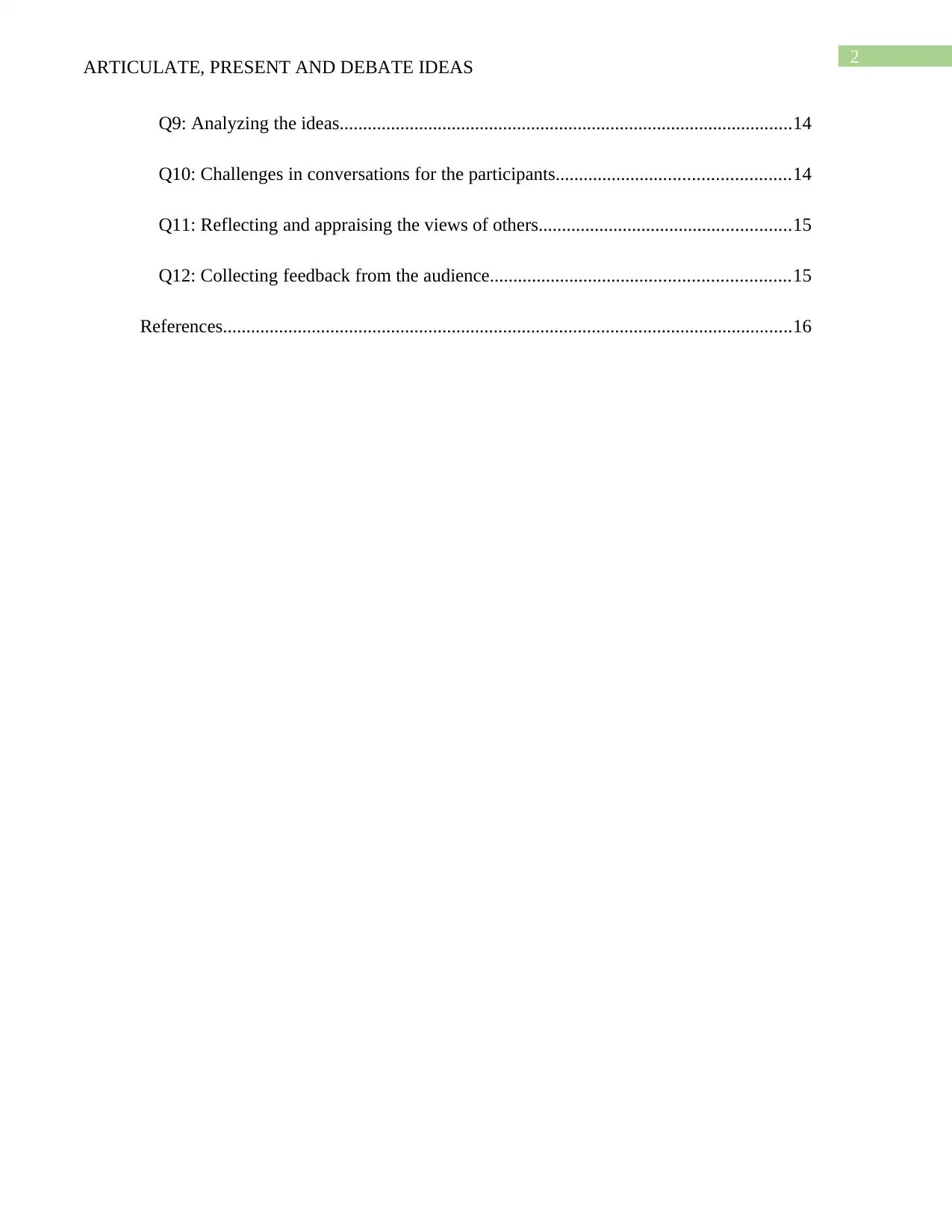
2
ARTICULATE, PRESENT AND DEBATE IDEAS
Q9: Analyzing the ideas.................................................................................................14
Q10: Challenges in conversations for the participants..................................................14
Q11: Reflecting and appraising the views of others......................................................15
Q12: Collecting feedback from the audience................................................................15
References..........................................................................................................................16
ARTICULATE, PRESENT AND DEBATE IDEAS
Q9: Analyzing the ideas.................................................................................................14
Q10: Challenges in conversations for the participants..................................................14
Q11: Reflecting and appraising the views of others......................................................15
Q12: Collecting feedback from the audience................................................................15
References..........................................................................................................................16
⊘ This is a preview!⊘
Do you want full access?
Subscribe today to unlock all pages.

Trusted by 1+ million students worldwide
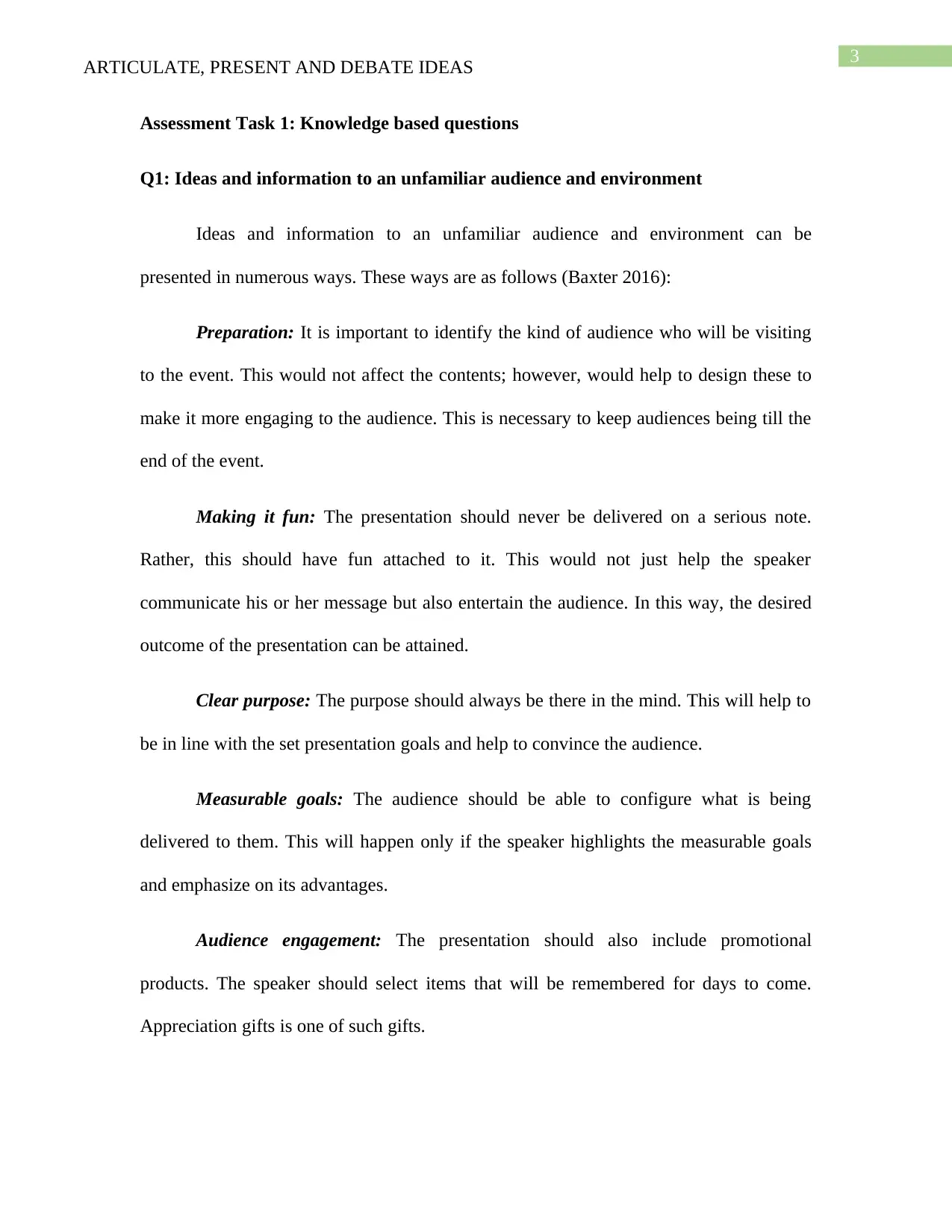
3
ARTICULATE, PRESENT AND DEBATE IDEAS
Assessment Task 1: Knowledge based questions
Q1: Ideas and information to an unfamiliar audience and environment
Ideas and information to an unfamiliar audience and environment can be
presented in numerous ways. These ways are as follows (Baxter 2016):
Preparation: It is important to identify the kind of audience who will be visiting
to the event. This would not affect the contents; however, would help to design these to
make it more engaging to the audience. This is necessary to keep audiences being till the
end of the event.
Making it fun: The presentation should never be delivered on a serious note.
Rather, this should have fun attached to it. This would not just help the speaker
communicate his or her message but also entertain the audience. In this way, the desired
outcome of the presentation can be attained.
Clear purpose: The purpose should always be there in the mind. This will help to
be in line with the set presentation goals and help to convince the audience.
Measurable goals: The audience should be able to configure what is being
delivered to them. This will happen only if the speaker highlights the measurable goals
and emphasize on its advantages.
Audience engagement: The presentation should also include promotional
products. The speaker should select items that will be remembered for days to come.
Appreciation gifts is one of such gifts.
ARTICULATE, PRESENT AND DEBATE IDEAS
Assessment Task 1: Knowledge based questions
Q1: Ideas and information to an unfamiliar audience and environment
Ideas and information to an unfamiliar audience and environment can be
presented in numerous ways. These ways are as follows (Baxter 2016):
Preparation: It is important to identify the kind of audience who will be visiting
to the event. This would not affect the contents; however, would help to design these to
make it more engaging to the audience. This is necessary to keep audiences being till the
end of the event.
Making it fun: The presentation should never be delivered on a serious note.
Rather, this should have fun attached to it. This would not just help the speaker
communicate his or her message but also entertain the audience. In this way, the desired
outcome of the presentation can be attained.
Clear purpose: The purpose should always be there in the mind. This will help to
be in line with the set presentation goals and help to convince the audience.
Measurable goals: The audience should be able to configure what is being
delivered to them. This will happen only if the speaker highlights the measurable goals
and emphasize on its advantages.
Audience engagement: The presentation should also include promotional
products. The speaker should select items that will be remembered for days to come.
Appreciation gifts is one of such gifts.
Paraphrase This Document
Need a fresh take? Get an instant paraphrase of this document with our AI Paraphraser
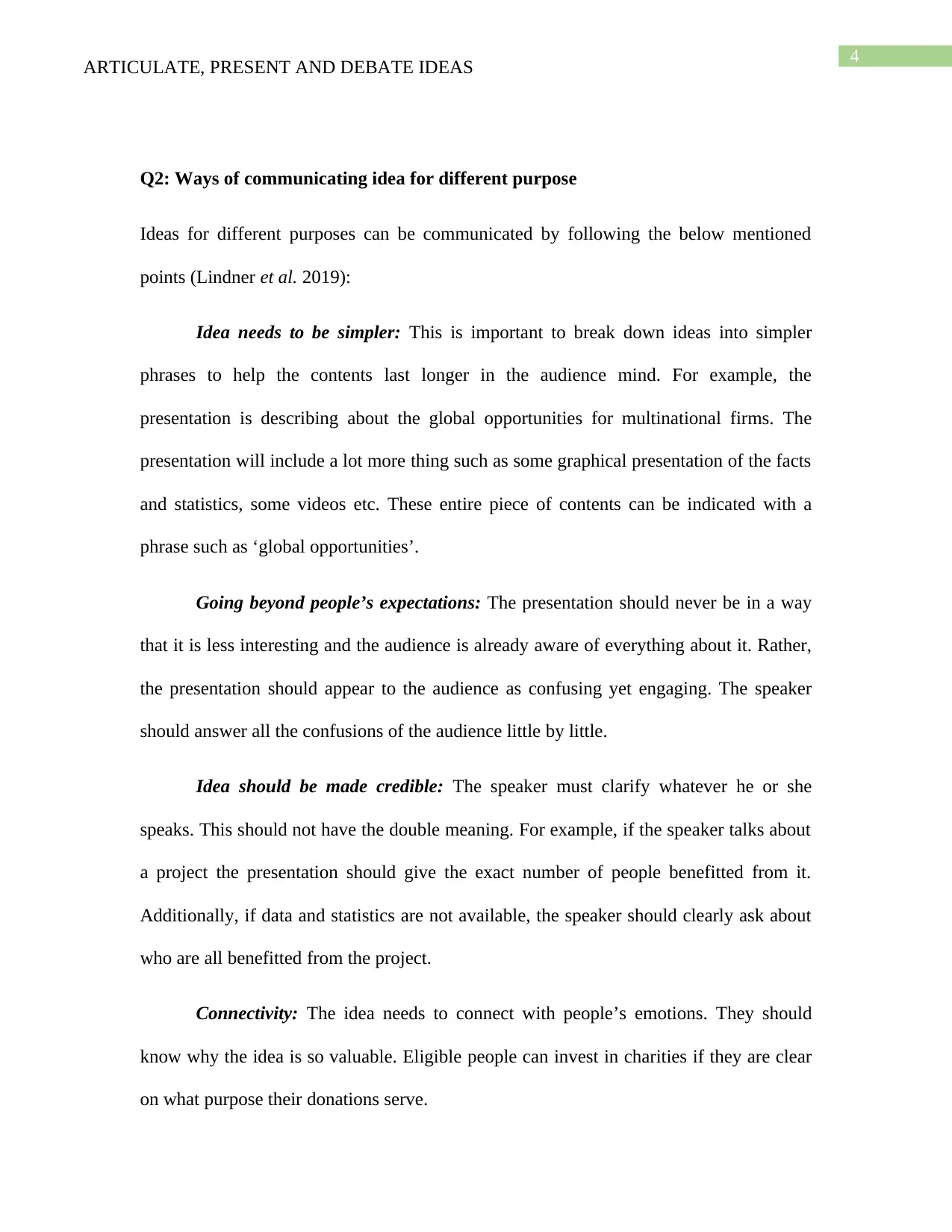
4
ARTICULATE, PRESENT AND DEBATE IDEAS
Q2: Ways of communicating idea for different purpose
Ideas for different purposes can be communicated by following the below mentioned
points (Lindner et al. 2019):
Idea needs to be simpler: This is important to break down ideas into simpler
phrases to help the contents last longer in the audience mind. For example, the
presentation is describing about the global opportunities for multinational firms. The
presentation will include a lot more thing such as some graphical presentation of the facts
and statistics, some videos etc. These entire piece of contents can be indicated with a
phrase such as ‘global opportunities’.
Going beyond people’s expectations: The presentation should never be in a way
that it is less interesting and the audience is already aware of everything about it. Rather,
the presentation should appear to the audience as confusing yet engaging. The speaker
should answer all the confusions of the audience little by little.
Idea should be made credible: The speaker must clarify whatever he or she
speaks. This should not have the double meaning. For example, if the speaker talks about
a project the presentation should give the exact number of people benefitted from it.
Additionally, if data and statistics are not available, the speaker should clearly ask about
who are all benefitted from the project.
Connectivity: The idea needs to connect with people’s emotions. They should
know why the idea is so valuable. Eligible people can invest in charities if they are clear
on what purpose their donations serve.
ARTICULATE, PRESENT AND DEBATE IDEAS
Q2: Ways of communicating idea for different purpose
Ideas for different purposes can be communicated by following the below mentioned
points (Lindner et al. 2019):
Idea needs to be simpler: This is important to break down ideas into simpler
phrases to help the contents last longer in the audience mind. For example, the
presentation is describing about the global opportunities for multinational firms. The
presentation will include a lot more thing such as some graphical presentation of the facts
and statistics, some videos etc. These entire piece of contents can be indicated with a
phrase such as ‘global opportunities’.
Going beyond people’s expectations: The presentation should never be in a way
that it is less interesting and the audience is already aware of everything about it. Rather,
the presentation should appear to the audience as confusing yet engaging. The speaker
should answer all the confusions of the audience little by little.
Idea should be made credible: The speaker must clarify whatever he or she
speaks. This should not have the double meaning. For example, if the speaker talks about
a project the presentation should give the exact number of people benefitted from it.
Additionally, if data and statistics are not available, the speaker should clearly ask about
who are all benefitted from the project.
Connectivity: The idea needs to connect with people’s emotions. They should
know why the idea is so valuable. Eligible people can invest in charities if they are clear
on what purpose their donations serve.
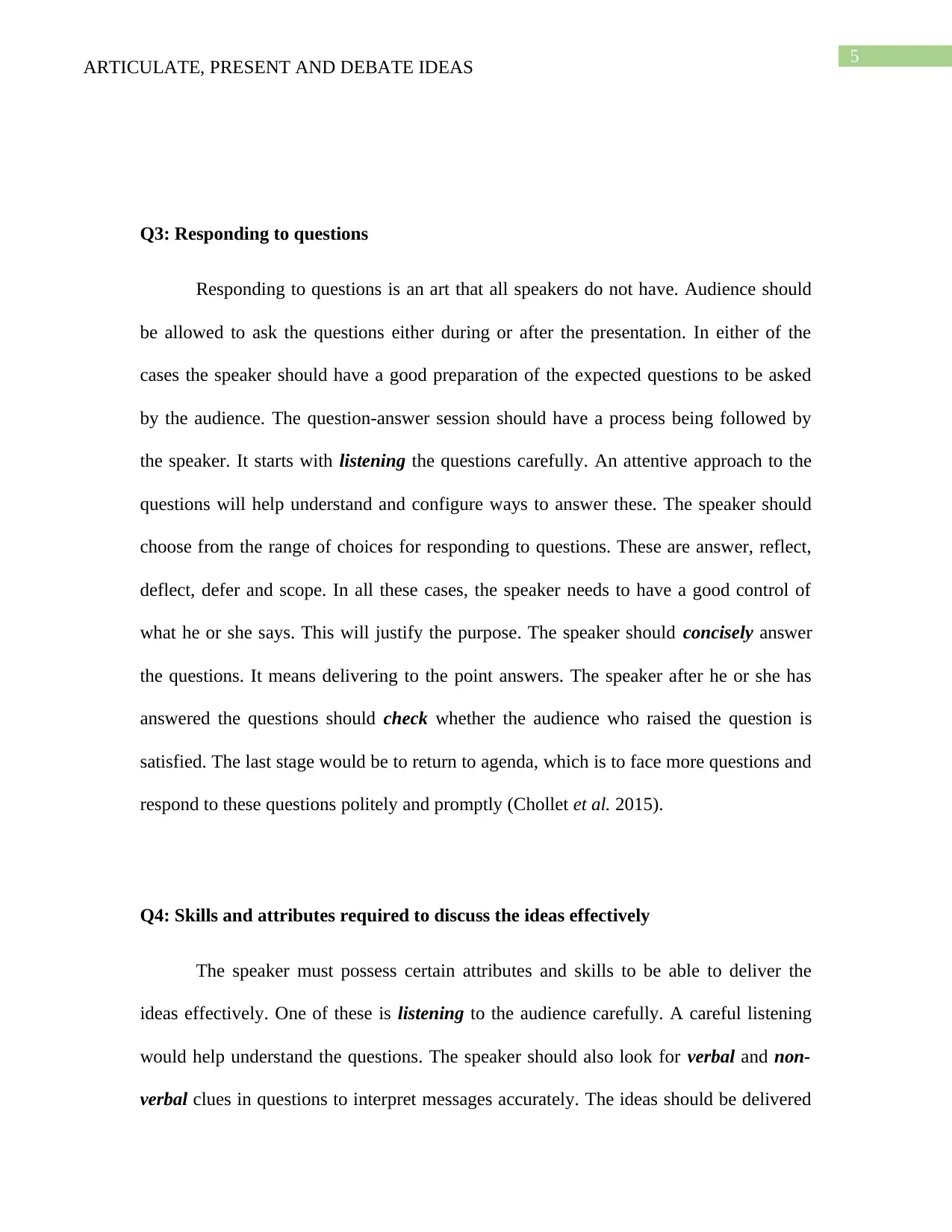
5
ARTICULATE, PRESENT AND DEBATE IDEAS
Q3: Responding to questions
Responding to questions is an art that all speakers do not have. Audience should
be allowed to ask the questions either during or after the presentation. In either of the
cases the speaker should have a good preparation of the expected questions to be asked
by the audience. The question-answer session should have a process being followed by
the speaker. It starts with listening the questions carefully. An attentive approach to the
questions will help understand and configure ways to answer these. The speaker should
choose from the range of choices for responding to questions. These are answer, reflect,
deflect, defer and scope. In all these cases, the speaker needs to have a good control of
what he or she says. This will justify the purpose. The speaker should concisely answer
the questions. It means delivering to the point answers. The speaker after he or she has
answered the questions should check whether the audience who raised the question is
satisfied. The last stage would be to return to agenda, which is to face more questions and
respond to these questions politely and promptly (Chollet et al. 2015).
Q4: Skills and attributes required to discuss the ideas effectively
The speaker must possess certain attributes and skills to be able to deliver the
ideas effectively. One of these is listening to the audience carefully. A careful listening
would help understand the questions. The speaker should also look for verbal and non-
verbal clues in questions to interpret messages accurately. The ideas should be delivered
ARTICULATE, PRESENT AND DEBATE IDEAS
Q3: Responding to questions
Responding to questions is an art that all speakers do not have. Audience should
be allowed to ask the questions either during or after the presentation. In either of the
cases the speaker should have a good preparation of the expected questions to be asked
by the audience. The question-answer session should have a process being followed by
the speaker. It starts with listening the questions carefully. An attentive approach to the
questions will help understand and configure ways to answer these. The speaker should
choose from the range of choices for responding to questions. These are answer, reflect,
deflect, defer and scope. In all these cases, the speaker needs to have a good control of
what he or she says. This will justify the purpose. The speaker should concisely answer
the questions. It means delivering to the point answers. The speaker after he or she has
answered the questions should check whether the audience who raised the question is
satisfied. The last stage would be to return to agenda, which is to face more questions and
respond to these questions politely and promptly (Chollet et al. 2015).
Q4: Skills and attributes required to discuss the ideas effectively
The speaker must possess certain attributes and skills to be able to deliver the
ideas effectively. One of these is listening to the audience carefully. A careful listening
would help understand the questions. The speaker should also look for verbal and non-
verbal clues in questions to interpret messages accurately. The ideas should be delivered
⊘ This is a preview!⊘
Do you want full access?
Subscribe today to unlock all pages.

Trusted by 1+ million students worldwide
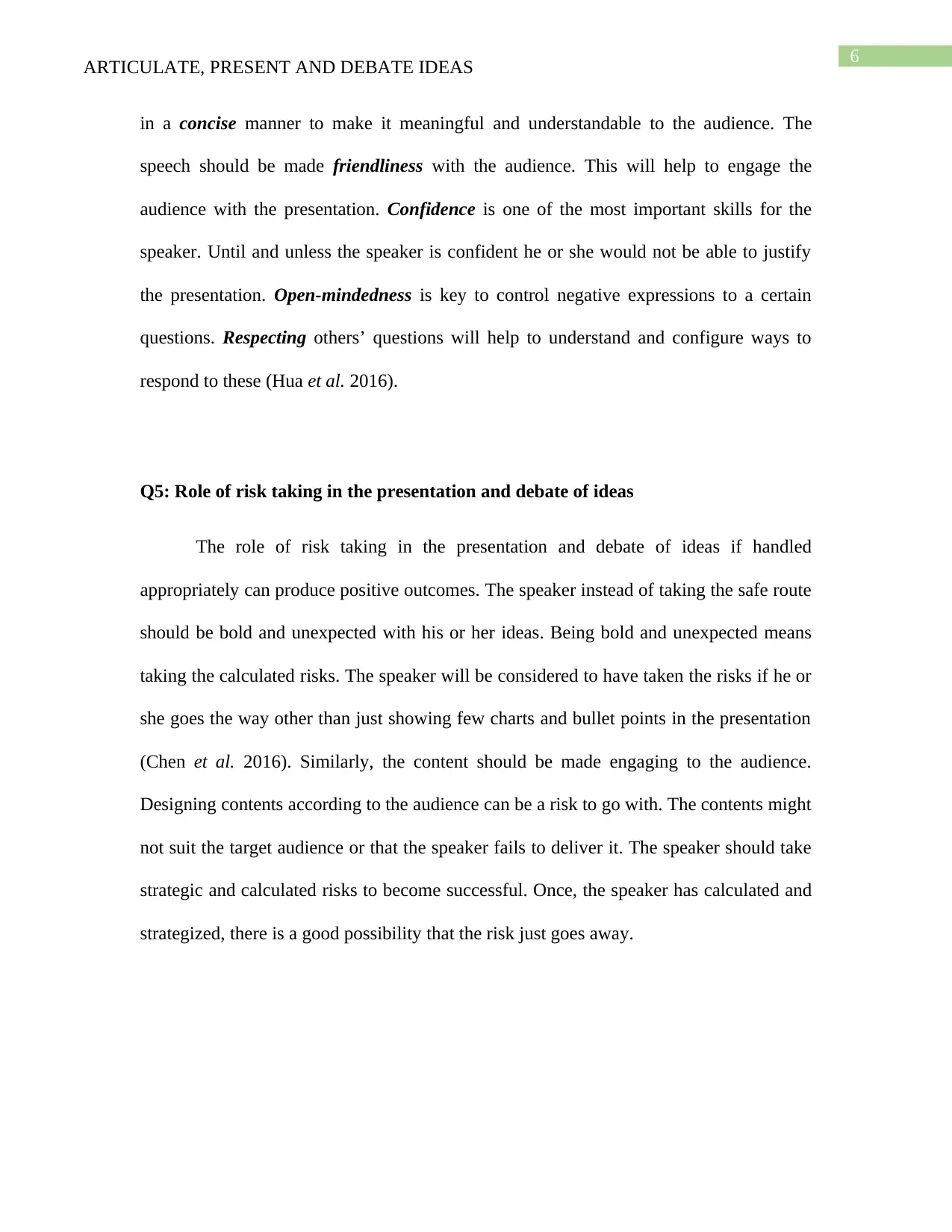
6
ARTICULATE, PRESENT AND DEBATE IDEAS
in a concise manner to make it meaningful and understandable to the audience. The
speech should be made friendliness with the audience. This will help to engage the
audience with the presentation. Confidence is one of the most important skills for the
speaker. Until and unless the speaker is confident he or she would not be able to justify
the presentation. Open-mindedness is key to control negative expressions to a certain
questions. Respecting others’ questions will help to understand and configure ways to
respond to these (Hua et al. 2016).
Q5: Role of risk taking in the presentation and debate of ideas
The role of risk taking in the presentation and debate of ideas if handled
appropriately can produce positive outcomes. The speaker instead of taking the safe route
should be bold and unexpected with his or her ideas. Being bold and unexpected means
taking the calculated risks. The speaker will be considered to have taken the risks if he or
she goes the way other than just showing few charts and bullet points in the presentation
(Chen et al. 2016). Similarly, the content should be made engaging to the audience.
Designing contents according to the audience can be a risk to go with. The contents might
not suit the target audience or that the speaker fails to deliver it. The speaker should take
strategic and calculated risks to become successful. Once, the speaker has calculated and
strategized, there is a good possibility that the risk just goes away.
ARTICULATE, PRESENT AND DEBATE IDEAS
in a concise manner to make it meaningful and understandable to the audience. The
speech should be made friendliness with the audience. This will help to engage the
audience with the presentation. Confidence is one of the most important skills for the
speaker. Until and unless the speaker is confident he or she would not be able to justify
the presentation. Open-mindedness is key to control negative expressions to a certain
questions. Respecting others’ questions will help to understand and configure ways to
respond to these (Hua et al. 2016).
Q5: Role of risk taking in the presentation and debate of ideas
The role of risk taking in the presentation and debate of ideas if handled
appropriately can produce positive outcomes. The speaker instead of taking the safe route
should be bold and unexpected with his or her ideas. Being bold and unexpected means
taking the calculated risks. The speaker will be considered to have taken the risks if he or
she goes the way other than just showing few charts and bullet points in the presentation
(Chen et al. 2016). Similarly, the content should be made engaging to the audience.
Designing contents according to the audience can be a risk to go with. The contents might
not suit the target audience or that the speaker fails to deliver it. The speaker should take
strategic and calculated risks to become successful. Once, the speaker has calculated and
strategized, there is a good possibility that the risk just goes away.
Paraphrase This Document
Need a fresh take? Get an instant paraphrase of this document with our AI Paraphraser
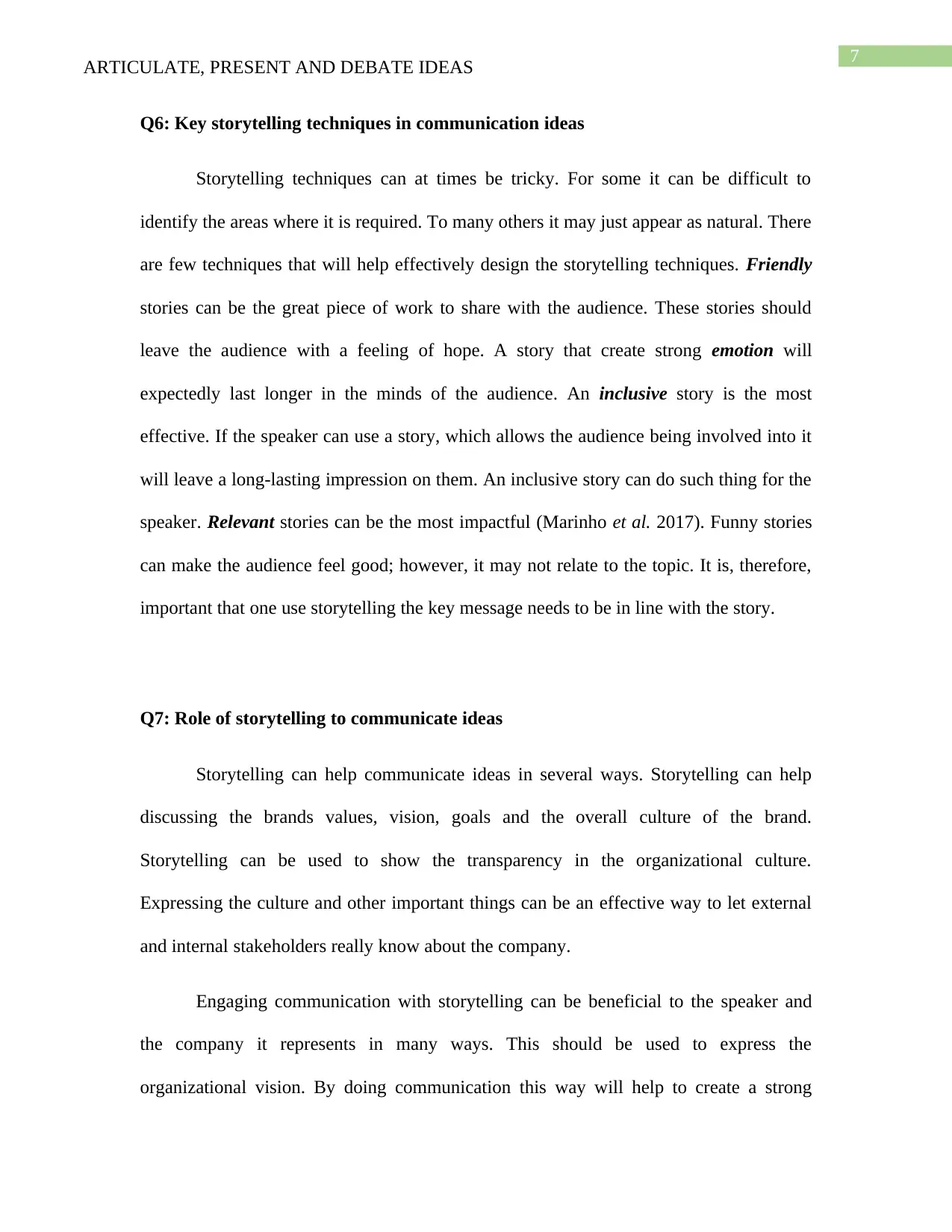
7
ARTICULATE, PRESENT AND DEBATE IDEAS
Q6: Key storytelling techniques in communication ideas
Storytelling techniques can at times be tricky. For some it can be difficult to
identify the areas where it is required. To many others it may just appear as natural. There
are few techniques that will help effectively design the storytelling techniques. Friendly
stories can be the great piece of work to share with the audience. These stories should
leave the audience with a feeling of hope. A story that create strong emotion will
expectedly last longer in the minds of the audience. An inclusive story is the most
effective. If the speaker can use a story, which allows the audience being involved into it
will leave a long-lasting impression on them. An inclusive story can do such thing for the
speaker. Relevant stories can be the most impactful (Marinho et al. 2017). Funny stories
can make the audience feel good; however, it may not relate to the topic. It is, therefore,
important that one use storytelling the key message needs to be in line with the story.
Q7: Role of storytelling to communicate ideas
Storytelling can help communicate ideas in several ways. Storytelling can help
discussing the brands values, vision, goals and the overall culture of the brand.
Storytelling can be used to show the transparency in the organizational culture.
Expressing the culture and other important things can be an effective way to let external
and internal stakeholders really know about the company.
Engaging communication with storytelling can be beneficial to the speaker and
the company it represents in many ways. This should be used to express the
organizational vision. By doing communication this way will help to create a strong
ARTICULATE, PRESENT AND DEBATE IDEAS
Q6: Key storytelling techniques in communication ideas
Storytelling techniques can at times be tricky. For some it can be difficult to
identify the areas where it is required. To many others it may just appear as natural. There
are few techniques that will help effectively design the storytelling techniques. Friendly
stories can be the great piece of work to share with the audience. These stories should
leave the audience with a feeling of hope. A story that create strong emotion will
expectedly last longer in the minds of the audience. An inclusive story is the most
effective. If the speaker can use a story, which allows the audience being involved into it
will leave a long-lasting impression on them. An inclusive story can do such thing for the
speaker. Relevant stories can be the most impactful (Marinho et al. 2017). Funny stories
can make the audience feel good; however, it may not relate to the topic. It is, therefore,
important that one use storytelling the key message needs to be in line with the story.
Q7: Role of storytelling to communicate ideas
Storytelling can help communicate ideas in several ways. Storytelling can help
discussing the brands values, vision, goals and the overall culture of the brand.
Storytelling can be used to show the transparency in the organizational culture.
Expressing the culture and other important things can be an effective way to let external
and internal stakeholders really know about the company.
Engaging communication with storytelling can be beneficial to the speaker and
the company it represents in many ways. This should be used to express the
organizational vision. By doing communication this way will help to create a strong
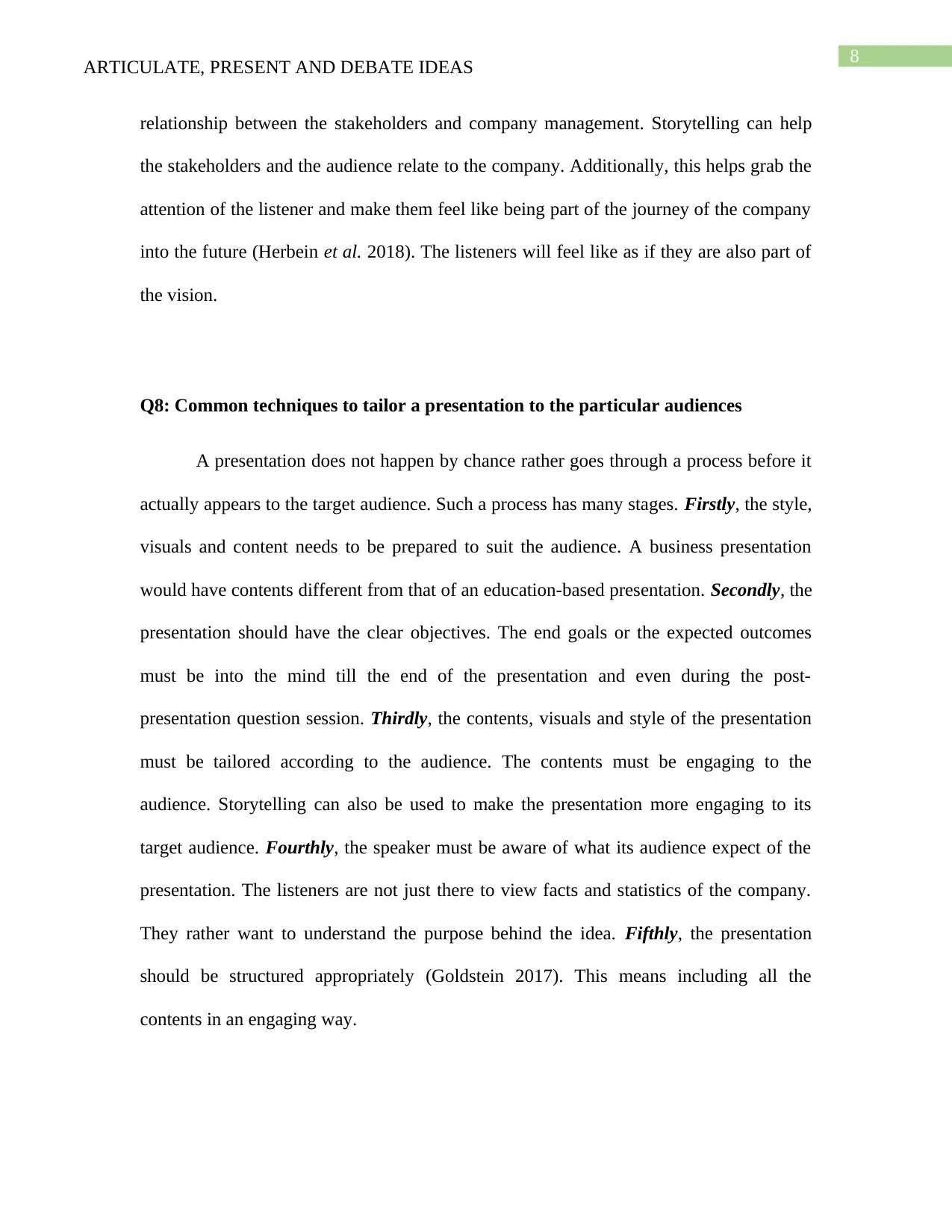
8
ARTICULATE, PRESENT AND DEBATE IDEAS
relationship between the stakeholders and company management. Storytelling can help
the stakeholders and the audience relate to the company. Additionally, this helps grab the
attention of the listener and make them feel like being part of the journey of the company
into the future (Herbein et al. 2018). The listeners will feel like as if they are also part of
the vision.
Q8: Common techniques to tailor a presentation to the particular audiences
A presentation does not happen by chance rather goes through a process before it
actually appears to the target audience. Such a process has many stages. Firstly, the style,
visuals and content needs to be prepared to suit the audience. A business presentation
would have contents different from that of an education-based presentation. Secondly, the
presentation should have the clear objectives. The end goals or the expected outcomes
must be into the mind till the end of the presentation and even during the post-
presentation question session. Thirdly, the contents, visuals and style of the presentation
must be tailored according to the audience. The contents must be engaging to the
audience. Storytelling can also be used to make the presentation more engaging to its
target audience. Fourthly, the speaker must be aware of what its audience expect of the
presentation. The listeners are not just there to view facts and statistics of the company.
They rather want to understand the purpose behind the idea. Fifthly, the presentation
should be structured appropriately (Goldstein 2017). This means including all the
contents in an engaging way.
ARTICULATE, PRESENT AND DEBATE IDEAS
relationship between the stakeholders and company management. Storytelling can help
the stakeholders and the audience relate to the company. Additionally, this helps grab the
attention of the listener and make them feel like being part of the journey of the company
into the future (Herbein et al. 2018). The listeners will feel like as if they are also part of
the vision.
Q8: Common techniques to tailor a presentation to the particular audiences
A presentation does not happen by chance rather goes through a process before it
actually appears to the target audience. Such a process has many stages. Firstly, the style,
visuals and content needs to be prepared to suit the audience. A business presentation
would have contents different from that of an education-based presentation. Secondly, the
presentation should have the clear objectives. The end goals or the expected outcomes
must be into the mind till the end of the presentation and even during the post-
presentation question session. Thirdly, the contents, visuals and style of the presentation
must be tailored according to the audience. The contents must be engaging to the
audience. Storytelling can also be used to make the presentation more engaging to its
target audience. Fourthly, the speaker must be aware of what its audience expect of the
presentation. The listeners are not just there to view facts and statistics of the company.
They rather want to understand the purpose behind the idea. Fifthly, the presentation
should be structured appropriately (Goldstein 2017). This means including all the
contents in an engaging way.
⊘ This is a preview!⊘
Do you want full access?
Subscribe today to unlock all pages.

Trusted by 1+ million students worldwide

9
ARTICULATE, PRESENT AND DEBATE IDEAS
ARTICULATE, PRESENT AND DEBATE IDEAS
Paraphrase This Document
Need a fresh take? Get an instant paraphrase of this document with our AI Paraphraser
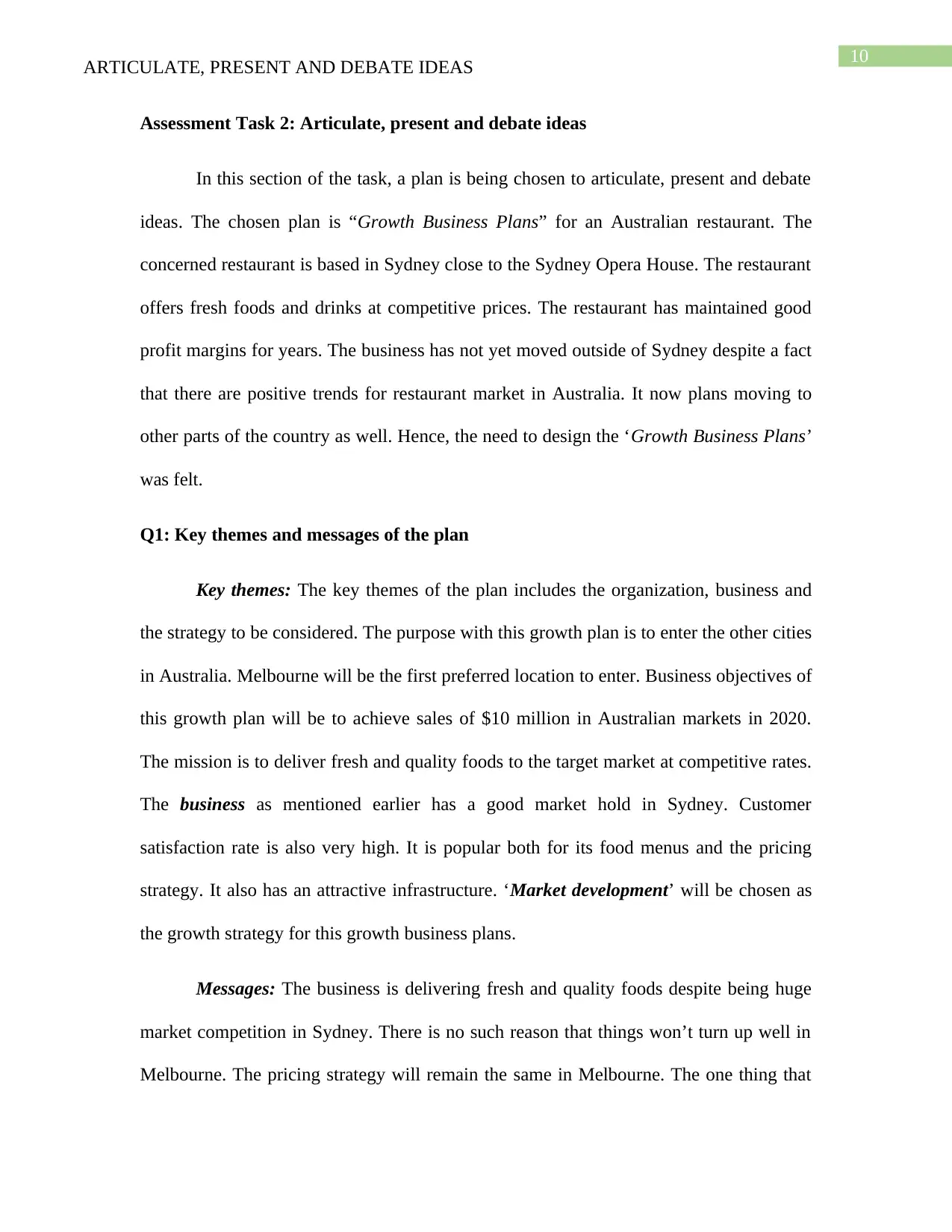
10
ARTICULATE, PRESENT AND DEBATE IDEAS
Assessment Task 2: Articulate, present and debate ideas
In this section of the task, a plan is being chosen to articulate, present and debate
ideas. The chosen plan is “Growth Business Plans” for an Australian restaurant. The
concerned restaurant is based in Sydney close to the Sydney Opera House. The restaurant
offers fresh foods and drinks at competitive prices. The restaurant has maintained good
profit margins for years. The business has not yet moved outside of Sydney despite a fact
that there are positive trends for restaurant market in Australia. It now plans moving to
other parts of the country as well. Hence, the need to design the ‘Growth Business Plans’
was felt.
Q1: Key themes and messages of the plan
Key themes: The key themes of the plan includes the organization, business and
the strategy to be considered. The purpose with this growth plan is to enter the other cities
in Australia. Melbourne will be the first preferred location to enter. Business objectives of
this growth plan will be to achieve sales of $10 million in Australian markets in 2020.
The mission is to deliver fresh and quality foods to the target market at competitive rates.
The business as mentioned earlier has a good market hold in Sydney. Customer
satisfaction rate is also very high. It is popular both for its food menus and the pricing
strategy. It also has an attractive infrastructure. ‘Market development’ will be chosen as
the growth strategy for this growth business plans.
Messages: The business is delivering fresh and quality foods despite being huge
market competition in Sydney. There is no such reason that things won’t turn up well in
Melbourne. The pricing strategy will remain the same in Melbourne. The one thing that
ARTICULATE, PRESENT AND DEBATE IDEAS
Assessment Task 2: Articulate, present and debate ideas
In this section of the task, a plan is being chosen to articulate, present and debate
ideas. The chosen plan is “Growth Business Plans” for an Australian restaurant. The
concerned restaurant is based in Sydney close to the Sydney Opera House. The restaurant
offers fresh foods and drinks at competitive prices. The restaurant has maintained good
profit margins for years. The business has not yet moved outside of Sydney despite a fact
that there are positive trends for restaurant market in Australia. It now plans moving to
other parts of the country as well. Hence, the need to design the ‘Growth Business Plans’
was felt.
Q1: Key themes and messages of the plan
Key themes: The key themes of the plan includes the organization, business and
the strategy to be considered. The purpose with this growth plan is to enter the other cities
in Australia. Melbourne will be the first preferred location to enter. Business objectives of
this growth plan will be to achieve sales of $10 million in Australian markets in 2020.
The mission is to deliver fresh and quality foods to the target market at competitive rates.
The business as mentioned earlier has a good market hold in Sydney. Customer
satisfaction rate is also very high. It is popular both for its food menus and the pricing
strategy. It also has an attractive infrastructure. ‘Market development’ will be chosen as
the growth strategy for this growth business plans.
Messages: The business is delivering fresh and quality foods despite being huge
market competition in Sydney. There is no such reason that things won’t turn up well in
Melbourne. The pricing strategy will remain the same in Melbourne. The one thing that
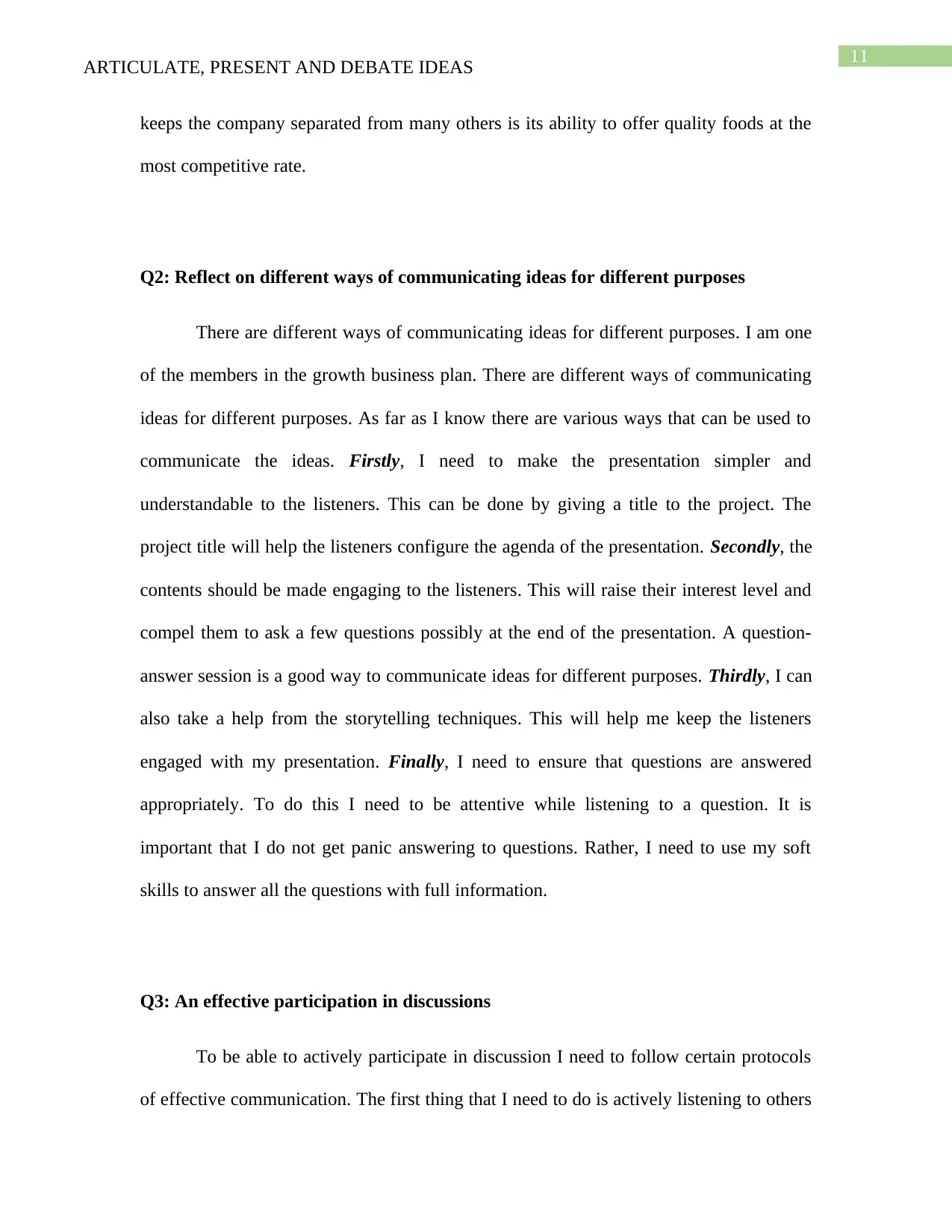
11
ARTICULATE, PRESENT AND DEBATE IDEAS
keeps the company separated from many others is its ability to offer quality foods at the
most competitive rate.
Q2: Reflect on different ways of communicating ideas for different purposes
There are different ways of communicating ideas for different purposes. I am one
of the members in the growth business plan. There are different ways of communicating
ideas for different purposes. As far as I know there are various ways that can be used to
communicate the ideas. Firstly, I need to make the presentation simpler and
understandable to the listeners. This can be done by giving a title to the project. The
project title will help the listeners configure the agenda of the presentation. Secondly, the
contents should be made engaging to the listeners. This will raise their interest level and
compel them to ask a few questions possibly at the end of the presentation. A question-
answer session is a good way to communicate ideas for different purposes. Thirdly, I can
also take a help from the storytelling techniques. This will help me keep the listeners
engaged with my presentation. Finally, I need to ensure that questions are answered
appropriately. To do this I need to be attentive while listening to a question. It is
important that I do not get panic answering to questions. Rather, I need to use my soft
skills to answer all the questions with full information.
Q3: An effective participation in discussions
To be able to actively participate in discussion I need to follow certain protocols
of effective communication. The first thing that I need to do is actively listening to others
ARTICULATE, PRESENT AND DEBATE IDEAS
keeps the company separated from many others is its ability to offer quality foods at the
most competitive rate.
Q2: Reflect on different ways of communicating ideas for different purposes
There are different ways of communicating ideas for different purposes. I am one
of the members in the growth business plan. There are different ways of communicating
ideas for different purposes. As far as I know there are various ways that can be used to
communicate the ideas. Firstly, I need to make the presentation simpler and
understandable to the listeners. This can be done by giving a title to the project. The
project title will help the listeners configure the agenda of the presentation. Secondly, the
contents should be made engaging to the listeners. This will raise their interest level and
compel them to ask a few questions possibly at the end of the presentation. A question-
answer session is a good way to communicate ideas for different purposes. Thirdly, I can
also take a help from the storytelling techniques. This will help me keep the listeners
engaged with my presentation. Finally, I need to ensure that questions are answered
appropriately. To do this I need to be attentive while listening to a question. It is
important that I do not get panic answering to questions. Rather, I need to use my soft
skills to answer all the questions with full information.
Q3: An effective participation in discussions
To be able to actively participate in discussion I need to follow certain protocols
of effective communication. The first thing that I need to do is actively listening to others
⊘ This is a preview!⊘
Do you want full access?
Subscribe today to unlock all pages.

Trusted by 1+ million students worldwide
1 out of 20
Related Documents
Your All-in-One AI-Powered Toolkit for Academic Success.
+13062052269
info@desklib.com
Available 24*7 on WhatsApp / Email
![[object Object]](/_next/static/media/star-bottom.7253800d.svg)
Unlock your academic potential
Copyright © 2020–2025 A2Z Services. All Rights Reserved. Developed and managed by ZUCOL.




